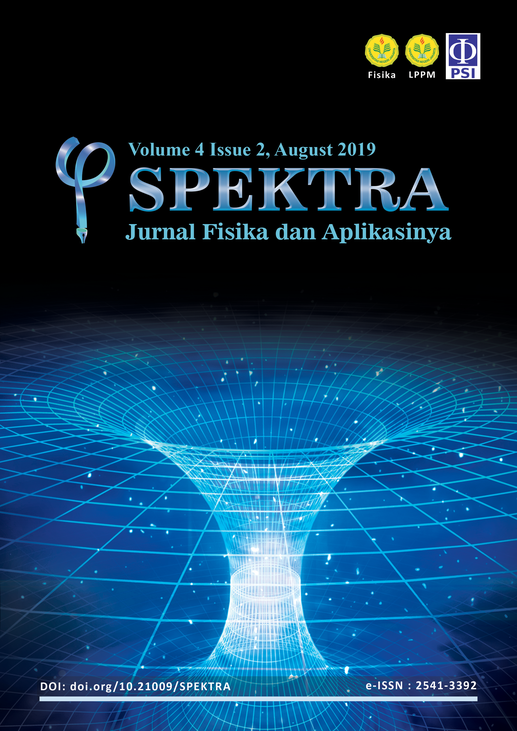BIOSENSOR SYSTEM DESIGN FOR DISSOLVED OXYGEN MEASUREMENT USING CURRENT MIRROR CIRCUIT
DOI:
https://doi.org/10.21009/SPEKTRA.042.05Keywords:
biosensor, dissolved oxygen, current mirror, amperometric, electrochemicalAbstract
A biosensor system using a current mirror circuit has been designed and characterized. Biosensor system usually implements an amperometric circuit such as a trans-impedance topology to measure current flowing in the solution due to the contained dissolved oxygen. The trans-impedance circuit implemented for the biosensor has some drawbacks and disadvantages. The implementation of this circuit exhibits rather high noise, besides the impracticality of the power supply used due to bipolar voltage need to allow negative voltage output. In this paper, a classical current mirror circuit is used to convert the flowing current in the solution. The use of the classical current mirror circuit is aimed to obtain lower noise level, besides the easiness in providing the power supply for the system, since the circuit consists only of small number of active components and does not need a bipolar power supply. The measurement is performed utilizing an algae species as a bio-receptor for the measured dissolved oxygen. By utilizing this circuit, the biosensor measurement system can be optimized with better precision and noise performance. Consequently, the dissolved oxygen measurements can be improved and achieve good results. Besides, the system can detect the changes in dissolved oxygen due to the photosynthetic process of the algae.
References
[2] B. Jang and A. Hassibi, “Biosensor systems in standard CMOS processes: Fact or fiction?” IEEE Trans. Ind. Electr., vol. 56, pp. 979–985, 2009.
[3] M. M. Ahmadi and G. A. Jullien, “Current-Mirror-Based Potentiostats for Three-Electrode Amperometric Electrochemical Sensors,” IEEE Transactions on Circuits and Systems I: Regular Papers, vol. 56, pp. 1339-1348, 2009.
[4] L. Zhang, Z. Yu and X. He, “Integrated Biosensor and Interfacing Circuits,” Biosensors, Editor: Pier Andrea Serra, IntechOpen, Croatia, pp. 302, 2010.
[5] E. Ghodsevali, S.l Morneau-Gamache, J. Mathault, H. Landari, É. Boisselier, M.Boukadoum, B. Gosselin and A. Miled, “Miniaturized FDDA and CMOS Based Potentiostat for Bio-Applications,” Sensors, 17, pp. 810, 2017.
[6] M. Tikyani and R. Pandey, “A New Low-Voltage Current Mirror Circuit with Enhanced Bandwidth,” International Conference on Computational Intelligence and Communication Systems, pp. 42–46, 2011.
[7] L. Umar, R. N. Setiadi, et al., “An Arduino Uno Based Biosensor for Water Pollution Monitoring using Immobilised Algae Chlorella Vulgaris,” International Journal on Smart Sensing and Intelligent Systems, vol. 10, pp. 955-975, 2017.
[8] L. Umar, Y. Hamzah, et al., “Biosensor signal improvement using current mirror topology for dissolved oxygen measurement,” Measurement Science and Technology, vol. 30, no. 6, pp. 065102, 2019.
Downloads
Published
How to Cite
Issue
Section
License
SPEKTRA: Jurnal Fisika dan Aplikasinya allow the author(s) to hold the copyright without restrictions and allow the author(s) to retain publishing rights without restrictions. SPEKTRA: Jurnal Fisika dan Aplikasinya CC-BY or an equivalent license as the optimal license for the publication, distribution, use, and reuse of scholarly work. In developing strategy and setting priorities, SPEKTRA: Jurnal Fisika dan Aplikasinya recognize that free access is better than priced access, libre access is better than free access, and libre under CC-BY or the equivalent is better than libre under more restrictive open licenses. We should achieve what we can when we can. We should not delay achieving free in order to achieve libre, and we should not stop with free when we can achieve libre.
 SPEKTRA: Jurnal Fisika dan Aplikasinya is licensed under a Creative Commons Attribution 4.0 International License.
SPEKTRA: Jurnal Fisika dan Aplikasinya is licensed under a Creative Commons Attribution 4.0 International License.
You are free to:
Share - copy and redistribute the material in any medium or format
Adapt - remix, transform, and build upon the material for any purpose, even commercially.
The licensor cannot revoke these freedoms as long as you follow the license terms.

 E-ISSN 2541-3392
E-ISSN 2541-3392  Focus & Scope
Focus & Scope  Editorial Team
Editorial Team  Reviewer Team
Reviewer Team  Author Guidelines
Author Guidelines  Article Template
Article Template  Author Fee
Author Fee  Publication Ethics
Publication Ethics  Plagiarism Policy
Plagiarism Policy  Open Access Policy
Open Access Policy  Peer Review Process
Peer Review Process  Retraction & Correction
Retraction & Correction  Licensing & Copyright
Licensing & Copyright  Archiving & Repository
Archiving & Repository  Contact
Contact  Mendeley
Mendeley 

